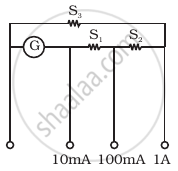Advertisements
Advertisements
Question
What are the advantages of using soft iron as a core, instead of steel, in the coils of galvanometers?
Solution
The material used as a core in the moving coil galvanometer undergoes cycle of magnetization for long period. Therefore, low hysterisis loss is the first requirement for such material. In soft ron core, area under the hysteresis curve is small thus loss of energy is less as compared to steel. Further, it is easily magnetized by the magnetizing field, which increase the magnetic field and hence sensitivity of galvanometer.
APPEARS IN
RELATED QUESTIONS
The combined resistance of a galvanometer of resistance 500Ω and its shunt is 21Ω. Calculate the value of shunt.
Show that the current flowing through a moving coil galvanometer is directly proportional to the angle of deflection of coil.
A circular coil of 250 turns and diameter 18 cm carries a current of 12A. What is the magnitude of magnetic moment associated with the coil?
Draw a labelled diagram of a moving coil galvanometer. Describe briefly its principle and working.
Explain how moving coil galvanometer is converted into a voltmeter. Derive the necessary formula.
Why is it necessary to introduce a radial magnetic field inside the coil of a galvanometer?
Can a galvanometer as such be used for measuring the current? Explain.
Why does a galvanometer when connected in series with a capacitor show a momentary deflection, when it is being charged or discharged?
How does this observation lead to modifying the Ampere's circuital law?
Hence write the generalised expression of Ampere's law.
Define the current sensitivity of a galvanometer ?
State the principle of the working of a moving coil galvanometer, giving its labeled diagram ?
Define the term 'current sensitivity' of a moving coil galvanometer.
The current sensitivity of a galvanometer is defined as ______.
In a moving coil galvanometer the deflection (Φ) on the scale by a pointer attached to the spring is ______.
A moving coil galvanometer can be converted into an ammeter by ______.
A multirange current meter can be constructed by using a galvanometer circuit as shown in figure. We want a current meter that can measure 10 mA, 100 mA and 1A using a galvanometer of resistance 10 Ω and that prduces maximum deflection for current of 1mA. Find S1, S2 and S3 that have to be used

When a galvanometer is shunted with a 4 Ω resistance, the deflection is reduced to one-fifth. If the galvanometer is further shunted with a 2 Ω wire. The further reduction (find the ratio of decrease in current to the previous current) in the deflection will be (the main current remains the same)
A galvanometer coil bas 500 turns and each tum has an average area of 3 × 10-4 m2. If a torque of 1.5 Nm is required to keep this coil parallel to a magnetic field when a current of 0.5 A is flowing through it, the strength of the field (in T) is ______.
A voltmeter has a range of 0 - 20 V and a resistance of 500 Q. Explain how can be used to measure voltages from 0 - 200 volt?
A moving coil galvanometer of resistance 55 Ω produces a full scale deflection for a current of 250 mA. How will you convert it into an ammeter with a range of 0 - 3A?
